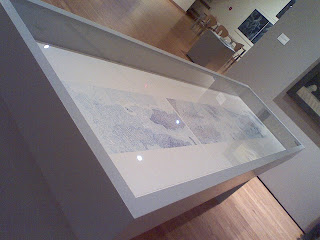As the rest of the show was made up of pieces from a wide variety of artists, and the show had no theme, it is hard to talk about the show as a whole except to say if the placement was done in poor judgment or not. As a whole I found the show to be interesting. I did not however find that it lent itself to going in any particular order. Knowing the gallery from past experience, I meandered at my own pace, following whatever piece struck my attention.

Patrick Strzelec
Syn 2010
Cast Aluminum, Limestone, Stainless Steel
4'x 3'x 3'
The first piece I was drawn to was Patrick Strzelec's "Syn". Both its positioning in the first room, as well as its color and aesthetic appeal drew me to this sculpture. I enjoyed the way this piece played off of Gary Khuen's piece. These sculptures are reminiscent of each other and the stark contrast between material choices and the bright green color Patrick chose really animate the main room.

Barbara Madsen
Endless 2010
Mixed Media
Dimensions Variable
The next piece I literally followed was the piece "endless" by Barbara Madsen. This piece starts in the main room of the gallery and appears to go through the wall. However, on the other side of the wall there is nothing. The rest of the piece is a good 15 feet away on a wall not connected to the original. This piece is visually striking with its hot pink colored tubing,shiny metal attachments, and its clean, white, smooth construction. There is also the captivating doors on the piece inviting the viewer to look in through them, as well as the open view from above, which reveals the 'pattered' floor. The smaller piece seems almost as if it could be put through the doors of the other piece, if it could simply melt backward through the wall. There is innate curiosity attached to this piece as you follow it through the gallery. Even to find the tag, one must search on another wall entirely. I appreciated how this was installed and I wonder if there were any specific instructions to be followed when it was installed or perhaps if Barb was there herself. One thing that was done in its installation was that both parts are maintained at the same height on the walls, and are therefore both viewed in the same way. I feel that depending on the artist's intention, it could be worth trying out to change the heights of the different sections. It is quite fun nonetheless and depending on where it was installed, the piece could be constantly changing.


Damian Catera
EOH v.v1 2010
Video
As I Made my way in the back corner of the gallery, I encountered two video installations. While both were certainly captivating, I felt specifically drawn to the projected piece. This used a distorted projection of music notes with accompanying sounds. I honestly was confused as to which piece was which and even now, am only guessing by the titles and style of the artists, Damian Catera and Ardele Lister. The second piece in the room was shown on a flat screen and was colorful television static in a continuous loop. This was also accompanied by sounds, but static sounds. In this way the two pieces significantly played off one another. One could argue either way if they help enhance the pieces or take away from them. Certainly the static piece 'does its job' in the sense that static makes people annoyed and it can be annoying to hear the crackling sounds over and over. However, having the sound in the room helps the viewer pay closer attention to the sounds in Damian's piece. Either way, the two certainly interact and are both visually and audibly stimulating and interesting.

Wendy White
CNC 2010
Acrylic on Canvas
37.5" x 43"
Wendy White's piece hadn't initially caught my attention but as I did come across it later, it struck me as interesting. She had modified the canvas to have extraneous shapes. In fact shapes that spelled out CNC, the title of the painting, but in the reverse. The work seems to be either airbrushed or dry brushed onto the canvas in a way that depicts spray paint. In fact, the entire piece had struck me right off the bat as having a direct graffiti feel to it. The colors are bright and there are graphic qualities to it. My only criticism of it, is that the hanging of this painting could have been better suited. It seemed to get lost in the corner where it was hung. Although, it was certainly a piece much different than a lot of the other work, and therefore did not necessarily fit in better anywhere else in the show.









